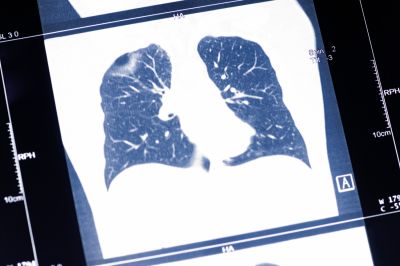Cancer remains one of the leading causes of mortality in Russia, second only to cardiovascular diseases. In 2022, about 250 thousand people died due to malignant neoplasms. Among the leading oncological diseases is lung cancer, which annually leads to almost 2 million deaths worldwide. The head of the radiation therapy department of the Russian Railways Central Clinical Hospital, Denis Romanov, spoke about cancer prevention, risk factor modification, and the importance of cooperation between the state, doctors, and patients.

Photo: ru.123rf.com
According to the expert, one of the most significant problems of modern healthcare in Russia and worldwide is lung cancer. It ranks first among all oncological diseases in terms of mortality. “This is largely due to its low detectability in the early stages of development,” Denis Romanov explained. – For example, according to the Federal State Budgetary Institution “National Medical Research Center of Radiology” of the Ministry of Health of Russia, about 70% of lung cancer cases in the country are diagnosed at late stages. In particular, we are talking about the third and fourth stages, when the possibilities of effective treatment are already significantly limited.”
According to the doctor, the main problem is that most patients do not seek medical help in a timely manner, mistakenly taking the first signs of cancer for symptoms of much less dangerous diseases. “One of such diseases is chronic bronchitis,” said Denis Romanov. – This is especially common among heavy smokers, for whom constant coughing or shortness of breath become the “norm”. The problem is exacerbated by insufficient coverage of the population by preventive programs and the lack of regular screenings. All this leads to the loss of precious time, which is so necessary for effective treatment of oncological diseases.”
According to the doctor, the situation with neoplasms of the head and neck in Russia is also a cause for serious concern. Squamous cell carcinoma of this area is quite common and is also often diagnosed at late stages, which makes treatment not only difficult, but also much less effective. “According to statistics, every second case of head and neck cancer is detected at a late stage,” the radiotherapist noted. – This is a terrifying figure. And despite the fact that the life expectancy for this type of cancer is somewhat higher than for lung cancer, its treatment is associated with severe side effects and high risks of recurrence.”
The expert calls unhealthy lifestyles, including smoking, unhealthy diet, physical inactivity, and other bad habits, one of the main reasons for the development of lung and head and neck cancers. “Interestingly, in general, the majority of Russians declare their commitment to a healthy lifestyle,” the radiotherapist emphasized. – Nevertheless, if we talk, for example, about smoking, then about a third of Russians continue to smoke, and this indicator has not changed for several years. But it is smoking that is considered the dominant factor influencing both the development of all these diseases and their outcome.”
Smoking negatively affects all stages of cancer treatment, the doctor noted. According to him, it worsens the tolerability of chemotherapy, increases the likelihood of complications after surgical interventions, and reduces the effectiveness of radiation therapy. “Patients who continue to smoke are less likely to achieve remission, and their risk of relapse remains high,” the oncologist said. – Giving up this addiction can significantly reduce the risk of developing a number of oncological diseases and improve treatment outcomes. Studies conducted in different countries confirm that patients who quit smoking even at the stage of an already diagnosed disease demonstrate higher survival rates, reduced frequency of complications, and improved quality of life in general.”
Thanks to progressive anti-tobacco legislation, the number of smokers in Russia has indeed decreased over ten years, Denis Romanov stated, but in recent years the decline has stopped. “This means that the effectiveness of the bans has exhausted its potential,” he commented. – It became necessary to look for new, more flexible and comprehensive approaches. This is especially important in terms of cancer prevention, since smoking cancer patients are a special population of smokers requiring a carefully verified differentiated approach.”
Within the framework of the fight against this addiction, special attention should be paid to the creation of state motivational programs aimed at quitting smoking, both at the prevention stage and during treatment, Denis Romanov believes. “Those who cannot or do not want to quit smoking can also be helped,” the oncologist continued. – Within the framework of the risk modification concept for heavy smokers with low motivation to quit, it is advisable to consider the possibility of switching to alternative smokeless products with reduced risk.”
Elimination of the harmful effects of tobacco smoke on the patient’s body helps reduce the likelihood of cancer and increase the chances of successful treatment of existing diseases, the doctor noted. “This is exactly what certified smokeless nicotine-containing products allow when complete quitting is not possible at the moment,” Denis Romanov emphasized. – For example, it has been proven that switching from regular cigarettes to smokeless alternatives reduces the amount of toxins and carcinogens entering the body with smoke. And although the risk is not completely reduced, this is a significant result for smoking cancer patients with severe tobacco dependence.”
A comprehensive approach to combating smoking as the main cause of lung and head and neck cancers also consists in creating a sustainable patient support system that includes educational programs and quality psychological assistance, the expert believes. These can be programs to reduce nicotine consumption, which provide a gradual change in patient behavior. “All these measures, along with the risk modification concept, must be accompanied by constant interaction between the state, the doctor, the patient, and society as a whole,” Denis Romanov is sure. – This is the only way to reduce the prevalence of smoking and cancer incidence in the country and significantly improve the quality of life of the population.”



